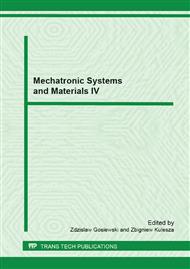p.539
p.547
p.553
p.559
p.565
p.571
p.577
p.583
p.589
Novel Concepts and Criteria for Design Optimization of Controlled Mechanical Systems
Abstract:
Controlled mechanical systems (CMS) are various robotic systems, vehicles/platforms with active suspension, and other engineering structures with active vibration/shape control. CMS have to be considered as functionally directed compositions of mutually influencing subsystems: control, actuator, structural, and sensor subsystems. Such systems have highly complex dynamics and an advanced conceptual framework is needed that considers at the same time the problems of full dynamic modelling, optimal system design, accurate parameter identification, and optimal robust control. There are various design tasks for controlled mechanical systems (CMS), where continuously increasing demands for higher speed, better motion accuracy, and reduced energy consumption are to be satisfied. In order to achieve such complicated performance optimization, it is very important to study their controllability and find efficient solutions for the control-related, design optimization problems. Our intention is to present novel concepts and criteria for design optimization of CMS with decentralized controllers at the lowest (joint) level. The first step is to find a dynamic model relating the control inputs and the controlled outputs which is suitable for both purposes: accurate parameter identification and robust control design. To do that, we can apply the so-called multibody system approach: the mechanical structure of CMS can be approximated by a composition of rigid bodies connected by joints, actuators, springs, and dampers. Then we find explicit necessary and sufficient conditions on the control transfer matrix that can guarantee robust controllability in the face of arbitrary, but bounded disturbances. Thus the design optimization process has to involve, besides the basic strength/load capacity criterion, additional design relations for optimal trade-off between the bounds of disturbances and the control force limits. The proposed approach enables decomposing the complex CMS design task into much simpler optimization problems for the CMS components: mechanical structure, actuators, sensors, and controllers. The new design concepts will be illustrated with several optimization examples of CMS concerning their shape, mass distribution, actuators' sizes and locations, and control functions.
Info:
Periodical:
Pages:
565-570
Citation:
Online since:
March 2013
Authors:
Keywords:
Price:
Сopyright:
© 2013 Trans Tech Publications Ltd. All Rights Reserved
Share:
Citation:


